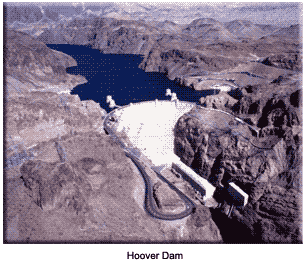Interest in constructing a dam on the Colorado River below the Grand Canyon had existed long before the onset of the Depression. Spring runoff of the melting snow in the Rocky Mountains led to predictable and often devastating floods in the rich Imperial Valley of southern California. The power of the annual torrent was so great that in 1905 the Colorado broke through a series of levees and filled an area that had been known as the Salton Sink; waters continued to pour into the area for two years and created what today is the Salton Sea — wiping out a number of towns in the process.
 Herbert Hoover was a California resident, avid fisherman and respected engineer. He developed an abiding interest in damming the Colorado and began to seriously look into the proposition while serving as the secretary of commerce under Calvin Coolidge. Progress was slowed, however, by a bitter fight among the states over the allocation of the river’s waters. Eventually, Hoover forged a compromise involving Arizona, California, Colorado, Nevada, New Mexico, Utah and Wyoming.
Congressional support was won in 1928, at the end of Coolidge’s presidency, when $177 million was appropriated. Not only would the dam provide flood control, but also water for irrigation and electrical power for the Southwest's growing population. The project began in 1931 on a site in Boulder Canyon between Arizona and Nevada. The first concrete was poured in 1933 and construction of the dam was completed in 1936; development of the power-generating facilities continued for several years.
The name of the dam was a matter of controversy. Officially, the undertaking was called the Bureau of Reclamation’s Boulder Canyon Project. In September 1930, the dam was named in honor of Hoover, the sitting president at the time, and in accordance with standard procedure for naming major public installations. Some critics, many Democrats among them, insisted during the Roosevelt era on using the names Boulder Dam or Boulder Canyon Dam, but these were never officially adopted. An act of Congress in 1947 fixed the name permanently as Hoover Dam.
Hoover was immensely proud of the engineering triumph that succeeded in raising the level of the Colorado River more than 600 feet and creating Lake Mead, the largest man-made reservoir in the United States. However, the project was so costly that it ruined any hope of achieving a balanced budget — a goal held dear by Hoover. There was little initial benefit to the nation’s economy, other than to the employees directly involved in the dam’s construction. Further, the power and water provided by the dam made possible the development of Las Vegas, the pleasure capital of the United States; this unplanned result probably did not please the strait-laced Hoover.
Herbert Hoover was a California resident, avid fisherman and respected engineer. He developed an abiding interest in damming the Colorado and began to seriously look into the proposition while serving as the secretary of commerce under Calvin Coolidge. Progress was slowed, however, by a bitter fight among the states over the allocation of the river’s waters. Eventually, Hoover forged a compromise involving Arizona, California, Colorado, Nevada, New Mexico, Utah and Wyoming.
Congressional support was won in 1928, at the end of Coolidge’s presidency, when $177 million was appropriated. Not only would the dam provide flood control, but also water for irrigation and electrical power for the Southwest's growing population. The project began in 1931 on a site in Boulder Canyon between Arizona and Nevada. The first concrete was poured in 1933 and construction of the dam was completed in 1936; development of the power-generating facilities continued for several years.
The name of the dam was a matter of controversy. Officially, the undertaking was called the Bureau of Reclamation’s Boulder Canyon Project. In September 1930, the dam was named in honor of Hoover, the sitting president at the time, and in accordance with standard procedure for naming major public installations. Some critics, many Democrats among them, insisted during the Roosevelt era on using the names Boulder Dam or Boulder Canyon Dam, but these were never officially adopted. An act of Congress in 1947 fixed the name permanently as Hoover Dam.
Hoover was immensely proud of the engineering triumph that succeeded in raising the level of the Colorado River more than 600 feet and creating Lake Mead, the largest man-made reservoir in the United States. However, the project was so costly that it ruined any hope of achieving a balanced budget — a goal held dear by Hoover. There was little initial benefit to the nation’s economy, other than to the employees directly involved in the dam’s construction. Further, the power and water provided by the dam made possible the development of Las Vegas, the pleasure capital of the United States; this unplanned result probably did not please the strait-laced Hoover.